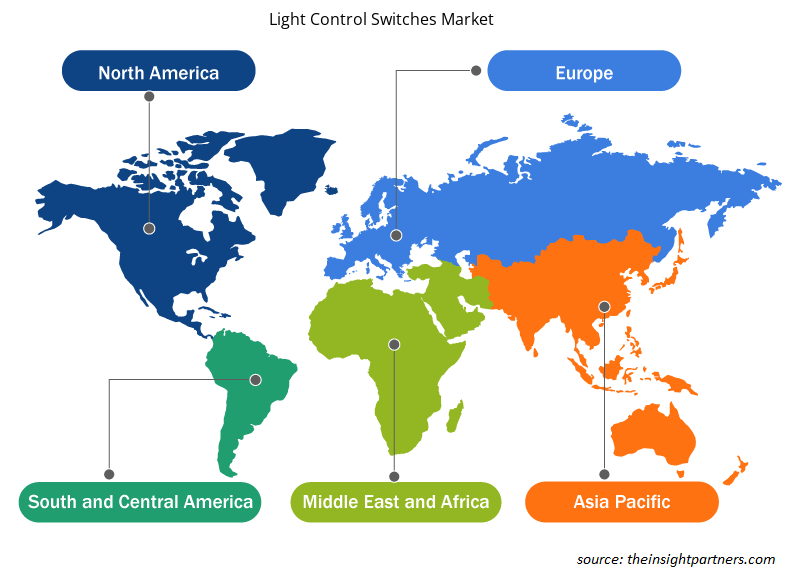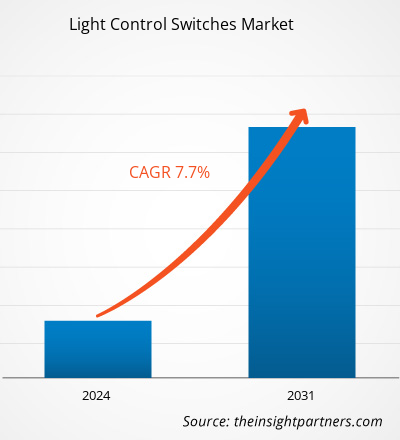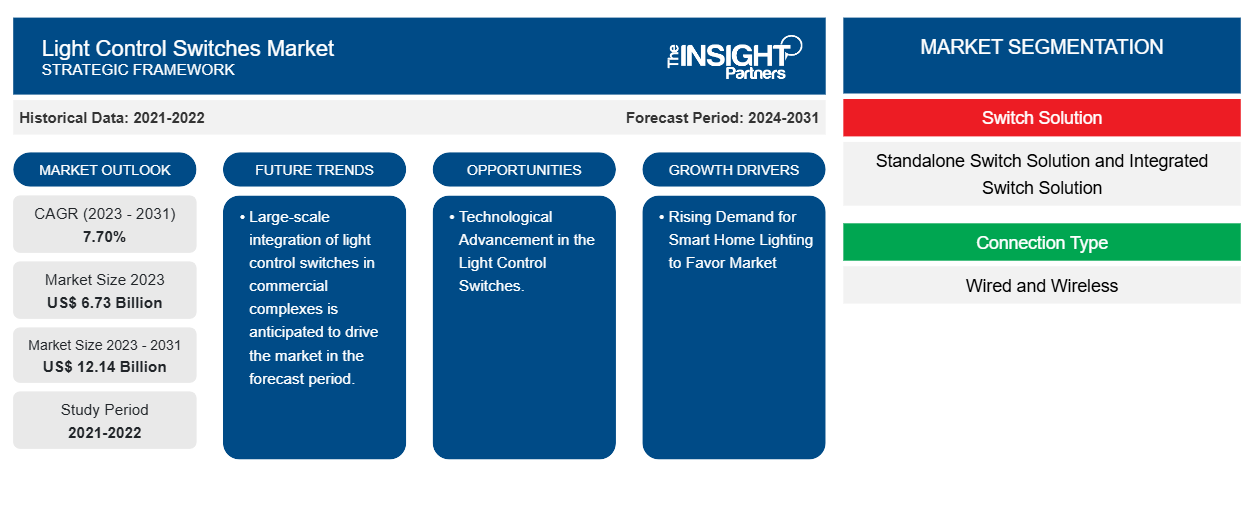Der Markt für Lichtsteuerungsschalter soll von 6,73 Milliarden US-Dollar im Jahr 2023 auf 12,14 Milliarden US-Dollar im Jahr 2031 anwachsen. Der Markt wird zwischen 2023 und 2031 voraussichtlich eine durchschnittliche jährliche Wachstumsrate von 7,70 % verzeichnen. Die steigende Nachfrage nach intelligenter Heimbeleuchtung und der zunehmende Bau von Gewerbekomplexen dürften die wichtigsten Treiber und Trends des Marktes sein.
Lichtsteuerungsschalter Marktanalyse
Der Markt für Lichtschalter verzeichnet weltweit ein deutliches Wachstum. Dieses Wachstum ist auf die steigende Nachfrage nach intelligenter Heimbeleuchtung und den zunehmenden Bau von Gewerbekomplexen zurückzuführen . Darüber hinaus wird erwartet, dass die großflächigere Integration von Lichtschaltern in Gewerbekomplexe, zunehmende staatliche Vorschriften und Anreize sowie die Integration von Smart Homes den Markt für Lichtschalter in den kommenden Jahren ankurbeln werden.
Marktübersicht für Lichtsteuerungsschalter
Ein Lichtschalter ist ein Schalter, der üblicherweise zum Bedienen von fest angeschlossenen Geräten, elektrischen Lampen oder Steckdosen verwendet wird. Tragbare Lampen, einschließlich Tischlampen, können einen Lichtschalter haben, der an der Fassung, am Sockel oder in der Leitung angebracht ist. Es gibt verschiedene Arten von Lichtschaltern, darunter einpolige Lichtschalter, zweipolige Lichtschalter, Dimmerschalter, Wippschalter, Kombinationslichtschalter, Doppellichtschalter, Dreifachlichtschalter und andere.
Passen Sie diesen Bericht Ihren Anforderungen an
Sie erhalten kostenlos individuelle Anpassungen an jedem Bericht, einschließlich Teilen dieses Berichts oder einer Analyse auf Länderebene, eines Excel-Datenpakets sowie tolle Angebote und Rabatte für Start-ups und Universitäten.
-
Holen Sie sich die wichtigsten Markttrends aus diesem Bericht.Dieses KOSTENLOSE Beispiel umfasst eine Datenanalyse von Markttrends bis hin zu Schätzungen und Prognosen.
Markttreiber und Chancen für Lichtsteuerungsschalter
Steigende Nachfrage nach Smart Home-Beleuchtung begünstigt den Markt
Smart Lights sind Glühbirnen und Beleuchtungskörper, die ihre Umgebung sowie Benutzer und andere Smart-Geräte automatisch erkennen und mit ihnen interagieren können. Die Nachfrage nach Smart Lighting wächst. Dieses Wachstum ist auf Energieeinsparungen zurückzuführen, da Smart Lighting weniger Energie verbraucht. Die Landschaft der Heimbeleuchtung entwickelt sich rasant, wobei Smart Lighting-Systeme nicht nur eine Möglichkeit bieten, Wohnräume zu personalisieren und aufzuwerten, sondern auch das übergeordnete Ziel der Energieeffizienz verfolgen. Mit dem technologischen Fortschritt wird die Integration und Interoperabilität von Smart Lighting mit Heimsystemen wahrscheinlich zu einer Standarderwartung von Hausbesitzern werden. Daher treiben die zunehmende Integration und Nachfrage nach Smart Home Lighting den Markt für Lichtsteuerungsschalter an.
Technologischer Fortschritt bei Lichtsteuerschaltern.
Der technologische Fortschritt bei Lichtschaltern kann erhebliche Chancen auf dem Markt für Lichtschalter schaffen. Intelligente Schalter, die den Energieverbrauch optimieren, können umweltbewusste Verbraucher und Unternehmen ansprechen, die ihre Stromkosten senken möchten. Zunehmende Integration von Fernsteuerungsautomatisierung und Anpassung und Personalisierung sowie Sicherheit und Schutz. Darüber hinaus können technologische Verbesserungen zu besseren Lichtdesigns führen, um Kunden anzulocken.eco-conscious consumers and businesses looking to reduce electricity costs. Increasing integration of remote-control automation and customization and personalization and
Marktbericht zu Lichtsteuerungsschaltern – Segmentierungsanalyse
Wichtige Segmente, die zur Ableitung der Marktanalyse für Lichtsteuerschalter beigetragen haben, sind Schalterlösung, Verbindungstyp und Endbenutzer.
- Basierend auf Schalterlösungen ist der Markt für Lichtsteuerungsschalter in eigenständige Schalterlösungen und integrierte Schalterlösungen unterteilt. Das Segment der eigenständigen Schalterlösungen wird im Prognosezeitraum voraussichtlich einen erheblichen Marktanteil halten.
- Basierend auf dem Verbindungstyp wird der Markt für Lichtsteuerungsschalter in kabelgebundene und kabellose unterteilt. Das kabelgebundene Segment wird im Prognosezeitraum voraussichtlich einen erheblichen Marktanteil halten.
- Nach Endverbraucher ist der Markt in gewerbliche, private, industrielle und öffentliche Versorgungsunternehmen unterteilt. Das gewerbliche Segment dürfte im Prognosezeitraum einen erheblichen Marktanteil halten.
Marktanteilsanalyse für Lichtsteuerungsschalter nach Geografie
Der geografische Umfang des Marktberichts für Lichtsteuerungsschalter ist hauptsächlich in fünf Regionen unterteilt: Nordamerika, Asien-Pazifik, Europa, Naher Osten und Afrika sowie Süd- und Mittelamerika.
APAC dominiert den Markt für Lichtsteuerungsschalter. Die Einführung von Hochtechnologie in verschiedenen Branchen der Region hat das Wachstum des Marktes für Lichtsteuerungsschalter vorangetrieben. Faktoren wie die zunehmende Einführung digitaler Tools und hohe Technologieausgaben von Regierungsbehörden werden voraussichtlich das Wachstum des Marktes für Lichtsteuerungsschalter in APAC vorantreiben. Die steigende Nachfrage nach intelligenter Heimbeleuchtung und der zunehmende Bau von Gewerbekomplexen in der Region. Darüber hinaus zwingt eine starke Betonung von Forschung und Entwicklung in den entwickelten Volkswirtschaften der USA und Kanadas die APAC-Akteure dazu, technologisch fortschrittliche Lösungen auf den Markt zu bringen. Darüber hinaus gibt es in den USA eine große Anzahl von Akteuren auf dem Markt für Lichtsteuerungsschalter, die sich zunehmend auf die Entwicklung innovativer Lösungen konzentrieren. All diese Faktoren tragen zum Wachstum des Marktes für Lichtsteuerungsschalter in der Region bei.
Regionale Einblicke in den Markt für Lichtsteuerungsschalter
Die regionalen Trends und Faktoren, die den Markt für Lichtsteuerungsschalter im Prognosezeitraum beeinflussen, wurden von den Analysten von Insight Partners ausführlich erläutert. In diesem Abschnitt werden auch die Marktsegmente und die Geografie von Lichtsteuerungsschaltern in Nordamerika, Europa, im asiatisch-pazifischen Raum, im Nahen Osten und Afrika sowie in Süd- und Mittelamerika erörtert.

- Erhalten Sie regionale Daten zum Markt für Lichtsteuerungsschalter
Umfang des Marktberichts über Lichtsteuerungsschalter
| Berichtsattribut | Details |
|---|---|
| Marktgröße im Jahr 2023 | 6,73 Milliarden US-Dollar |
| Marktgröße bis 2031 | 12,14 Milliarden US-Dollar |
| Globale CAGR (2023 - 2031) | 7,70 % |
| Historische Daten | 2021-2022 |
| Prognosezeitraum | 2024–2031 |
| Abgedeckte Segmente |
Von Switch Solution
|
| Abgedeckte Regionen und Länder |
Nordamerika
|
| Marktführer und wichtige Unternehmensprofile |
|
Marktteilnehmerdichte: Der Einfluss auf die Geschäftsdynamik
Der Markt für Lichtsteuerungsschalter wächst rasant, angetrieben durch die steigende Endverbrauchernachfrage aufgrund von Faktoren wie sich entwickelnden Verbraucherpräferenzen, technologischen Fortschritten und einem größeren Bewusstsein für die Vorteile des Produkts. Mit steigender Nachfrage erweitern Unternehmen ihr Angebot, entwickeln Innovationen, um die Bedürfnisse der Verbraucher zu erfüllen, und nutzen neue Trends, was das Marktwachstum weiter ankurbelt.
Die Marktteilnehmerdichte bezieht sich auf die Verteilung der Firmen oder Unternehmen, die in einem bestimmten Markt oder einer bestimmten Branche tätig sind. Sie gibt an, wie viele Wettbewerber (Marktteilnehmer) in einem bestimmten Marktraum im Verhältnis zu seiner Größe oder seinem gesamten Marktwert präsent sind.
Die wichtigsten auf dem Markt für Lichtsteuerungsschalter tätigen Unternehmen sind:
- Gesellschaften, beginnend mit ACUITY
- Eaton
- Honeywell International Inc.
- LEGRAND SA
- Leviton Manufacturing Inc.
- Lutron Electronics Co., Inc
Haftungsausschluss : Die oben aufgeführten Unternehmen sind nicht in einer bestimmten Reihenfolge aufgeführt.

- Überblick über die wichtigsten Akteure auf dem Markt für Lichtsteuerungsschalter
Marktnachrichten und aktuelle Entwicklungen zu Lichtsteuerungsschaltern
Der Markt für Lichtsteuerungsschalter wird durch die Erhebung qualitativer und quantitativer Daten nach Primär- und Sekundärforschung bewertet, die wichtige Unternehmensveröffentlichungen, Verbandsdaten und Datenbanken umfasst. Nachfolgend sind einige der Entwicklungen auf dem Markt für Lichtsteuerungsschalter aufgeführt:
- In diesem Frühjahr bringt Forbes & Lomax seinen neuen Mehrwege-Dimmschalter auf den Markt. Mit dem Dimmschalter können Sie das Licht von bis zu drei Stellen aus dimmen, ohne dass zusätzliche Pakete erforderlich sind. Mehrwege-Dimmschalter können problemlos nachgerüstet werden. (Quelle: Forbes & Lomax Company Website, Mai 2024)
- ABB hat mit Busch-art linear eine Reihe hochwertiger Lichtschalter vorgestellt, die sich in Gebäudeautomationssysteme integrieren lassen und Nachhaltigkeit und Premium-Design bieten. (Quelle: ABB-Unternehmenswebsite, März 2024)
Marktbericht zu Lichtsteuerungsschaltern – Abdeckung und Ergebnisse
Der Bericht „Marktgröße und Prognose für Lichtsteuerungsschalter (2021–2031)“ bietet eine detaillierte Analyse des Marktes, die die folgenden Bereiche abdeckt:
- Marktgröße und Prognose für Lichtsteuerungsschalter auf globaler, regionaler und Länderebene für alle wichtigen Marktsegmente, die im Rahmen des Berichts abgedeckt sind
- Markttrends für Lichtsteuerungsschalter sowie Marktdynamik wie Treiber, Einschränkungen und wichtige Chancen
- Detaillierte PEST/Porters Five Forces- und SWOT-Analyse
- Marktanalyse für Lichtsteuerungsschalter, die wichtige Markttrends, globale und regionale Rahmenbedingungen, wichtige Akteure, Vorschriften und aktuelle Marktentwicklungen umfasst
- Branchenlandschaft und Wettbewerbsanalyse, die die Marktkonzentration, Heatmap-Analyse, prominente Akteure und aktuelle Entwicklungen auf dem Markt für Lichtsteuerungsschalter umfasst
- Detaillierte Firmenprofile
- Historische Analyse (2 Jahre), Basisjahr, Prognose (7 Jahre) mit CAGR
- PEST- und SWOT-Analyse
- Marktgröße Wert/Volumen – Global, Regional, Land
- Branchen- und Wettbewerbslandschaft
- Excel-Datensatz
Aktuelle Berichte
Verwandte Berichte
Erfahrungsberichte
Grund zum Kauf
- Fundierte Entscheidungsfindung
- Marktdynamik verstehen
- Wettbewerbsanalyse
- Kundeneinblicke
- Marktprognosen
- Risikominimierung
- Strategische Planung
- Investitionsbegründung
- Identifizierung neuer Märkte
- Verbesserung von Marketingstrategien
- Steigerung der Betriebseffizienz
- Anpassung an regulatorische Trends























 Kostenlose Probe anfordern für - Markt für Lichtsteuerungsschalter
Kostenlose Probe anfordern für - Markt für Lichtsteuerungsschalter